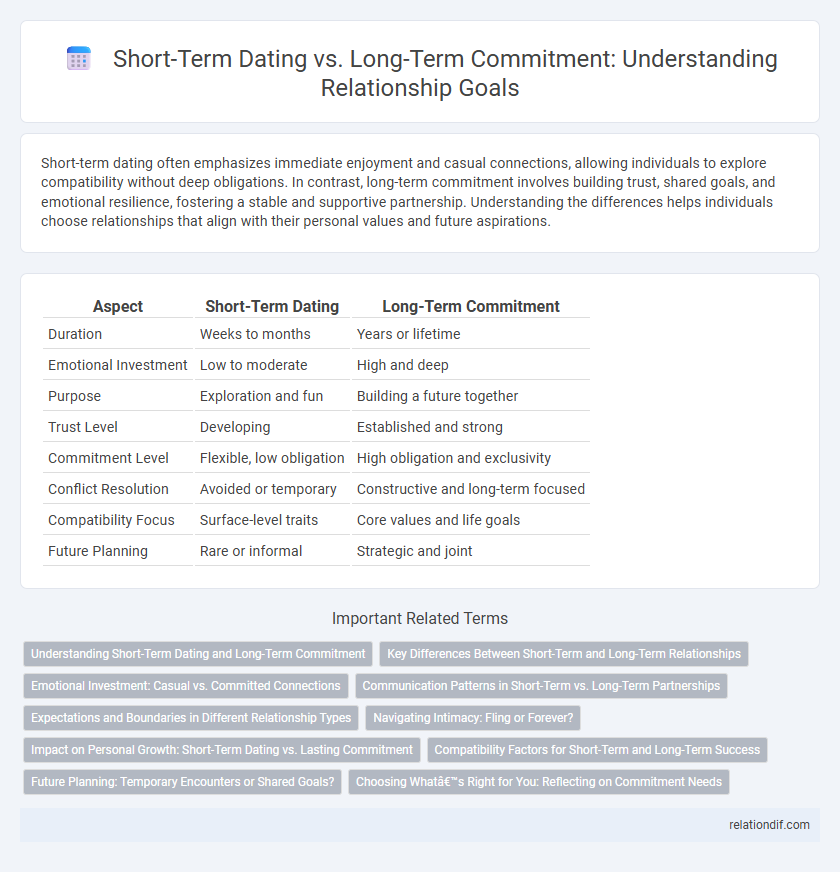Short-term dating often emphasizes immediate enjoyment and casual connections, allowing individuals to explore compatibility without deep obligations. In contrast, long-term commitment involves building trust, shared goals, and emotional resilience, fostering a stable and supportive partnership. Understanding the differences helps individuals choose relationships that align with their personal values and future aspirations.
Table of Comparison
| Aspect | Short-Term Dating | Long-Term Commitment |
|---|---|---|
| Duration | Weeks to months | Years or lifetime |
| Emotional Investment | Low to moderate | High and deep |
| Purpose | Exploration and fun | Building a future together |
| Trust Level | Developing | Established and strong |
| Commitment Level | Flexible, low obligation | High obligation and exclusivity |
| Conflict Resolution | Avoided or temporary | Constructive and long-term focused |
| Compatibility Focus | Surface-level traits | Core values and life goals |
| Future Planning | Rare or informal | Strategic and joint |
Understanding Short-Term Dating and Long-Term Commitment
Short-term dating often involves exploring compatibility and enjoyment without deep emotional involvement, focusing on immediate connection and fun. Long-term commitment emphasizes trust-building, emotional support, and shared goals, requiring consistent effort and effective communication. Understanding these differences helps individuals navigate relationship expectations and personal boundaries more clearly.
Key Differences Between Short-Term and Long-Term Relationships
Short-term dating often centers on immediate attraction and enjoyment without future planning, emphasizing flexibility and spontaneity. Long-term commitment requires emotional investment, trust building, and shared goals that foster stability and growth over time. Communication frequency and conflict resolution styles differ significantly, with long-term relationships prioritizing deep understanding and compromise.
Emotional Investment: Casual vs. Committed Connections
Short-term dating often involves lower emotional investment, prioritizing exploration and fun without deep attachment. Long-term commitment requires consistent emotional effort, fostering trust, vulnerability, and mutual support over time. Committed connections build a foundation of shared experiences and emotional security that casual relationships typically lack.
Communication Patterns in Short-Term vs. Long-Term Partnerships
Communication patterns in short-term dating often prioritize surface-level interactions and immediate emotional expression, focusing on excitement and novelty. In contrast, long-term commitment relies on deeper, consistent communication that fosters trust, conflict resolution, and emotional intimacy. Effective long-term partnerships emphasize active listening, empathy, and transparent dialogue to sustain relational growth over time.
Expectations and Boundaries in Different Relationship Types
Short-term dating often involves flexible expectations and looser boundaries, prioritizing exploration and individual freedom. Long-term commitment requires clear communication about mutual goals, emotional support, and established boundaries to foster trust and stability. Understanding these differences helps partners navigate relationship dynamics and align their intentions effectively.
Navigating Intimacy: Fling or Forever?
Short-term dating often emphasizes exploration and excitement with minimal emotional investment, allowing individuals to test compatibility without the pressure of permanence. Long-term commitment requires deeper emotional intimacy, trust, and mutual support, fostering a foundation for sustained connection and personal growth. Navigating intimacy involves assessing readiness for vulnerability and aligning relationship goals to determine whether a fling or forever is the best path forward.
Impact on Personal Growth: Short-Term Dating vs. Lasting Commitment
Short-term dating often encourages exploration and self-discovery, providing diverse experiences that can enhance emotional intelligence and social skills. In contrast, lasting commitment fosters deeper personal growth by promoting stability, trust, and emotional resilience within a consistent partnership. Research indicates that long-term relationships contribute significantly to mental well-being and sustained personal development compared to transient dating experiences.
Compatibility Factors for Short-Term and Long-Term Success
Compatibility factors for short-term dating often prioritize immediate attraction, shared interests, and spontaneous excitement, fostering quick emotional connections. In contrast, long-term commitment depends heavily on core values alignment, effective communication, emotional stability, and mutual life goals to ensure sustained relationship growth. Understanding these distinct compatibility elements can significantly impact the success and satisfaction in both short-term and long-term romantic relationships.
Future Planning: Temporary Encounters or Shared Goals?
Short-term dating often centers on spontaneous experiences without extensive future planning, prioritizing immediate enjoyment over long-term goals. In contrast, long-term commitment involves shared visions and collaborative decision-making, including financial planning, family aspirations, and lifestyle alignment. Establishing clear future objectives distinguishes temporary encounters from partnerships built on enduring mutual growth.
Choosing What’s Right for You: Reflecting on Commitment Needs
Short-term dating offers flexibility for exploring personal preferences and understanding emotional boundaries without the pressures of long-term expectations. Long-term commitment requires a deep evaluation of shared values, future goals, and emotional compatibility to foster lasting trust and stability. Reflecting on individual commitment needs helps prioritize relationship goals aligned with personal growth and happiness.
short-term dating vs long-term commitment Infographic

 relationdif.com
relationdif.com